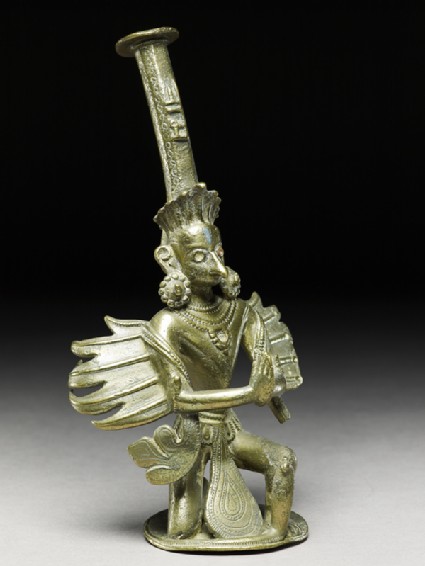Personal devotion
A selection of objects from different world religions used in personal devotion.

Collection trails: 15 objects
Incense holder in the form of Garuda
-
Details
- Associated place
-
Asia › India › central India › Madhya Pradesh (place of creation)
- Date
- 19th century (1801 - 1900)
- Material and technique
- brass
- Dimensions
- 22 x 10.5 x 10 cm max. (height x width x depth)
- Material index
-
processed material › metal › alloy › copper alloy › brass
- Technique index
- Object type index
- No. of items
- 1
- Credit line
- Presented by Mrs C. E. Luard, 1936.
- Accession no.
- EAX.281
-
Further reading
Harle, J. C., and Andrew Topsfield, Indian Art in the Ashmolean Museum (Oxford: Ashmolean Museum, 1987), no. 71g on pp. 61-64, pp. xii & 64, illus. p. 63
Location
Objects are sometimes moved to a different location. Our object location data is usually updated on a monthly basis. Contact the Jameel Study Centre if you are planning to visit the museum to see a particular object on display, or would like to arrange an appointment to see an object in our reserve collections.
Galleries
Publications online
-

Indian Art in the Ashmolean Museum
These seven objects belonged to a large collection of brass images, ritual objects, implements, ornaments and toys which was formed by Major (later colonel) C. Eckford Luard in the former Central Indian Agency between 1900 and 1903. Luard served in this area for a number of years as Superintendent of Gazetteer and of Census Operations. He compiled the several volumes of Central Indian State Gazetteers (1907-12), as well as writing other works, including guide-books to Dhar and Mandu and the Dilwara temples at Mount Abu. In later life he lived at Boar’s Hill, Oxford, and part of his collection was presented to the Indian Institute’s museum by his widow in 1936 [see EAOS.108]. Luard’s earlier article describing the collection in the Journal of Indian Art and Industry is still useful in the identification of regional types of such late brass objects, which are otherwise scantily documented.
Another incense holder is in the form of Viṣṇu’s vehicle, the celestial bird Garuḍa [EAX.281], represented as a beak-nosed bird-man kneeling in the gesture of adoration or salutation (añjali-mudrā). Flame-like wings and hanging drapes (damaged at the right side) emanate from his upper arms. A snake (nāga) – traditionally Garuḍa’s enemy and his chief food – rests docilely in front of him. On the tubular agarbatti-holder rising from his crown the name of the god Rām appears in relief.
Collection trails
© 2013 University of Oxford - Ashmolean Museum









